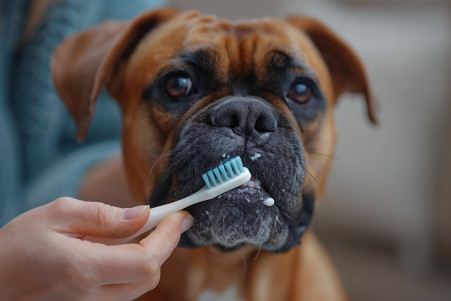How Much Do Dog X-Rays Cost? What Pet Parents Can Expect
23 March 2024 • Updated 21 March 2024

The price of an X-ray for your dog can vary widely based on location, the vet’s office, and the complexity of the X-ray. On average, dog X-rays cost between $80 and $400, with basic X-rays on the lower end and more complicated procedures like contrast X-rays on the higher end. Since many vet offices include the cost of X-rays in the price of an office visit, it’s important to ask for a detailed estimate.
To help you better understand these costs, we’ll take a look at the primary factors that impact the cost of dog X-rays across the U.S. From the costs associated with maintaining imaging equipment to the discounts offered by some vet offices, this guide will walk pet parents through what they can expect when their dog needs radiographic imaging. Armed with this information, you’ll be better prepared to budget for this important diagnostic procedure.
How much do dog X-rays cost?
What Affects the Cost of a Dog X-Ray?
As reported by MetLife Pet Insurance, the size of your dog is one of the most important factors that will determine the cost of an X-ray. This is because larger dogs will require more sedation, which can increase the cost. The part of the body being X-rayed is also a factor, with dental and abdominal X-rays being more expensive than X-rays of legs and paws.
Meanwhile, Pawlicy Advisor explains that the cost of sedation alone can range from $50 to $350, depending on the size and temperament of the dog. Dogs that are more anxious or nervous may require more sedation or even general anesthesia, which will increase the cost of the X-ray.
Where you live is another important factor. Paoli Vetcare explains that the cost of X-rays is generally higher in urban areas and big cities with a higher cost of living. Meanwhile, the type of veterinary practice you go to can also make a difference, with teaching hospitals and non-profit clinics generally being cheaper than private practices, according to Canine Journal.
Knowing these main factors that affect the cost of a dog X-ray can help pet parents better plan for the financial implications of having their dog X-rayed and look for ways to save money. Being prepared will help ensure a positive experience that's focused on your dog's well-being.
How to Get Your Dog Ready for an X-Ray
The Fairfield County Vets | South Wilton Veterinary Group says that there is usually no special preparation needed for a dog's X-ray. However, grooming and making sure that the dog is clean can help ensure that the images come out as clear as possible. Owners should let the vet know about any medications, medical issues, or anxiety that their dog is dealing with because these things can impact how much sedation is needed.
According to the Greensboro Veterinarian, if the dog is in pain, anxious, or can't stay still, sedation or anesthesia may be needed for the X-ray. The vet will assess the dog and decide if an X-ray is needed based on the symptoms or issues that they're seeing.
The Salazar Veterinary Hospital explains that during the X-ray, the dog will be positioned and held still so that the technician can get the best possible images of the area or organ system that they're focusing on. This positioning is important to make sure that the X-ray images are of the best quality.
When Is an X-Ray Needed for a Dog?
X-rays are used to diagnose a variety of issues in dogs, including fractures, masses, foreign bodies, and orthopedic problems, according to Everything You Need To Know About X-Rays For Dogs. They are especially useful for finding foreign bodies, bladder stones, and other dense objects in the body.
Dental X-rays should be done at least once a year to look for things like cavities, periodontal disease, and oral tumors, according to The Importance of Dental X-rays in Dogs | VCA Animal Hospitals. For senior dogs over the age of 7, X-rays of the hips, spine, and other areas may be recommended during wellness exams to look for signs of aging, according to How Often Should I Take My Dog to the Vet? A Puppy to Senior Dog Vet Timeline.
X-rays are often used in conjunction with other diagnostic tests, such as blood tests and physical exams, to get a complete picture of a dog's health, according to Radiographs (X-Rays) for Dogs | VCA Animal Hospitals. Knowing when X-rays are needed can help dog owners anticipate potential expenses and make sure their dogs get the thorough care they need.
How to Save Money on Dog X-Rays
If you have pet insurance, you may be able to save money on X-rays. Many pet insurance plans cover X-rays for accidents and illnesses and reimburse 70% or more of the cost, according to Pet Insurance Review. Some pet insurance providers also offer wellness plans that cover diagnostic services like X-rays for a lower fee.
For people who want to save even more money, Lemonade Insurance suggests taking your dog to a veterinary teaching hospital that’s part of a university. These hospitals are often much cheaper than private practices.
You may also be able to get help with the cost of X-rays through breed-specific, condition-specific, or state-based pet healthcare assistance programs, according to the American Kennel Club. Finally, make sure to get quotes from multiple vets to make sure you’re getting the best price.
These are just a few ways that you may be able to save money on dog X-rays. By taking advantage of these options, you can make sure your pet gets the care they need without spending more than you have to.
Know the Importance of Dog X-Rays
X-rays enable us to assess your dog's internal health and reveal details that may not be visible to the naked eye. X-rays can show pregnancy, fractures, masses, organ enlargement, foreign bodies, and more, according to Mill Plain Vet.
Most of the time, an X-ray will be performed when the dog is brought in for a specific issue or another diagnostic test. Because of this, there is no special preparation needed. Your vet will check your dog in, and if they determine that an X-ray is necessary, they will take the time to walk you through the process and what they are looking for, as stated by Rock Hill Vet.
In some cases, the dog will need to be sedated to get a clear X-ray. If your dog is cooperative, not in a lot of pain, and can lay in the position needed for the X-ray without any issues, sedation will not be necessary. However, if your dog is in pain, anxious, or not cooperating, your vet will likely recommend sedation. Your vet may also recommend sedation if they need your dog's muscles to be relaxed to get a clear image, according to Mill Plain Vet.
Radiography is safe, painless, and non-invasive. It uses only very low doses of radiation. Because the amount of radiation exposure required to perform X-rays is so minimal, it is safe to perform X-rays on pregnant dogs, according to Mill Plain Vet.
Final Insights: Understanding the Costs of Dog X-Rays
While X-rays can be costly for dog owners, they are an essential diagnostic tool for identifying and treating many different conditions in dogs. By learning about average prices, factors that can impact the cost, and ways to save money, dog owners can be better prepared to handle the financial burden of X-rays.
In the end, the advantages of early detection and treatment through X-ray imaging often justify the costs and help ensure that dogs are healthy in the long run. Dog owners should talk to their vets about when X-rays are necessary and discuss ways to make the procedure more cost-effective.


